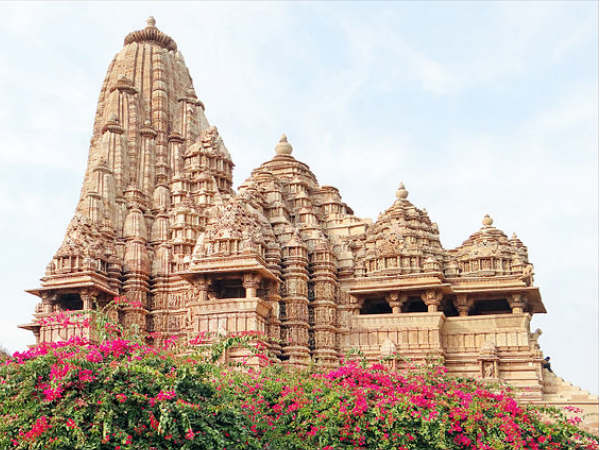These days its easy to find a 40-storey building in metro cities around the world and people go crazy about the fascination of such buildings. This article is about a time when there were no machines, no cement, no cranes and great structures were created just by carving huge stones. Every stone carved on it had a meaning, and a great history behind it. In this article, you will get to know about one of the most beautiful man-made wonders that has gone unnoticed in this busy growing world. We are talking about the marvel of Kandariya Mahadev (A holy temple dedicated to Lord Shiva), one of the largest and most eye-catching temples that have been built in the medieval age. The “Kandariya Mahadev” which means the great god of the cave is located in the Chattarpur district of Madhya Pradesh in central India. Built in 1030 A.D., this architectural brilliance is not just an ordinary temple, the history behind this will leave you wondering as to how this monument has not made it in the top wonders of the world.
We all know the history that India has been through over the last millennium. There were invasions almost every decade and approximately 33000 temples have been lost during the last 1000 years. The story behind this goes back to 1019 A.D., when Mahmud of Ghazni (Ruler of Ghazni, Afghanistan) tried to invade Khajuraho (Capital of Chandela Dynasty). Chandela dynasty was then ruled by the great King Vidyadhara who is also famous for creating temples dedicated to Hindu deities like Vishnu, Surya, Shakti etc. When Mahmud launched an attack on Khajuraho he had to face shear force of the brave warriors of Chandela chanting “Har Har Mahadev” and stopping the Mahmud of Ghazni in making any sort of advancements on the battlefield. The battle was not conclusive as Mahmud was forced to retreat back to Ghazni. In 1022 A.D. again Mahmud returned with vengeance and attacked the fort of Kalinjar, but the siege was yet again unsuccessful as the soldiers of the Chandela made it very difficult for the barbarians to climb and conquer. King Vidhyadhara was successful again and the whole Chandela civilization believed that Lord Shiva is protecting them from the caves of Khajuraho. The people celebrated this victory by creating the great Kandariya Mahavdev Temple, dedicated to their beloved deity Lord Shiva. Inscriptions on the entrance of the mandir (temple), mention the name of the builder as Virimda, which is the pseudonym for King Vidhyadhara. The legend of Vidhyadhara is very important in the history of Hinduism as he fought to protect the great culture of the oldest religion on the planet. While other temples were being lost by invasions across the country, this artistic creation is an example of the resilience shown by the people who can do anything to save the culture of the land. However, in years to come since then, many temples were lost due to Mughal invasions but this great creation till date remains untouched.
The temple stands 31 meters tall founded on a plinth of about 4.5 meters. The structure is created in reference to Mount Meru which is known as the source for creating the world. The shikhara (top roof) of the temple is made of 84 miniature spires, all crafted by real hands. One interesting fact is that the western group of Khajuraho temples consisting of Kandariya, Matangeshwara and Vishwanatha make a cosmic design of hexagon or a Cosmo-gram. The level of advancements that our ancestors made in science can be seen from this. At the entrance of the 6-km layout temple, there is a torona, a garland carved from a single stone. These carvings right from the entrance show the quality of material used and the character of builders which were no less than artists. The carvings are of lions, circles, spirals and other geometrical figures. On the inside, the temple consists of three halls in the form of rising steps called as “mandaps” in Hindi language. There is a separate chamber which has the Shiva linga, the emblem of Lord Shiva which is worshipped by billions across the world. Pillars of the halls have features of scroll motif. Corners of the halls are made of incised patterns. It also has interlinked passages and balconies. The main tower is built by interlinking a series of towers and spires, which gives the temple a shape of the mountain range of Mount Kailasa of Himlayas, where Lord Shiva resides.
That was just a brief about the interiors, talking about the exteriors there are horizontal images carved with images which shine bright in the sunlight replicating the Agni god (God of Fire). Exteriors also include finely carved mithuna postures with maidens flanking the couple. There is also a male figure upside down in a yogic pose, which shows that yoga has been with us since ages. Sculptures also have Saptamatrikas (seven goddesses) along with Lord Ganesha and Veerbhadra. The Saptamatrikas are very difficult to draw on paper, imagine the creativity as they were carved on stones.
The great Vedic knowledge has been preserved and passed on by our ancestors for many generations just by the help of stones and not any kind of text books. The Kandariya Mahadev Temple is a great example of preserving the oldest culture on the planet. In this attempt to let the world know about such architectural brilliance which is of utmost importance to the history of Indian culture, I conclude on one of the many lost temples, The Great Kandariya Mahadev.
By Aman Singh, Mumbai
















